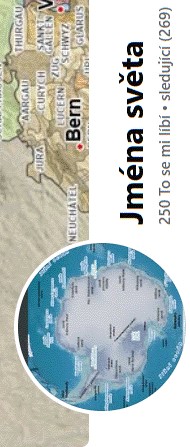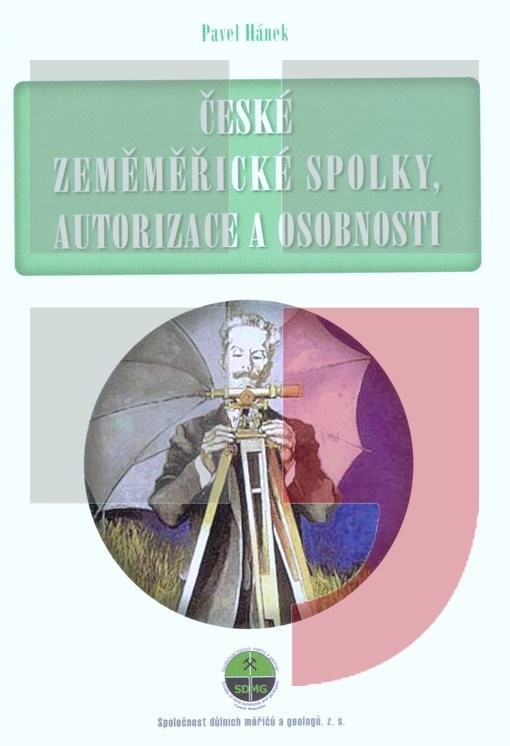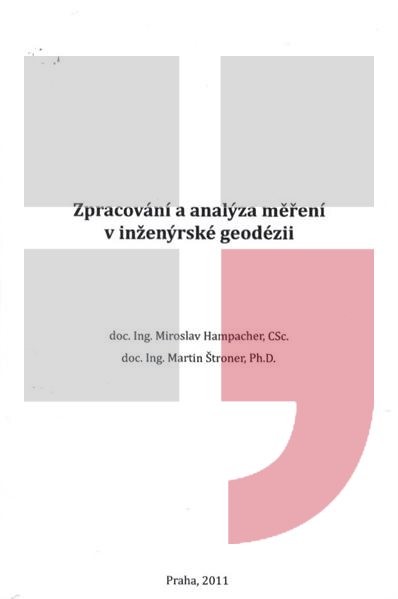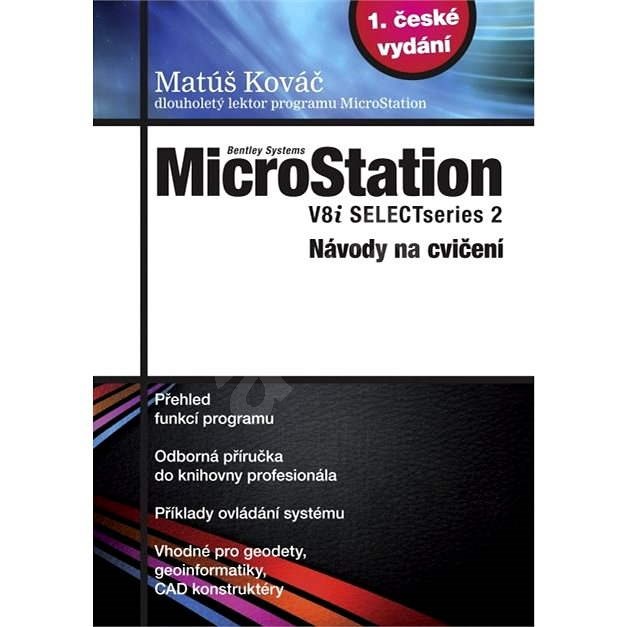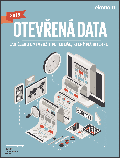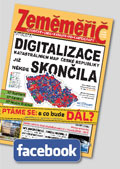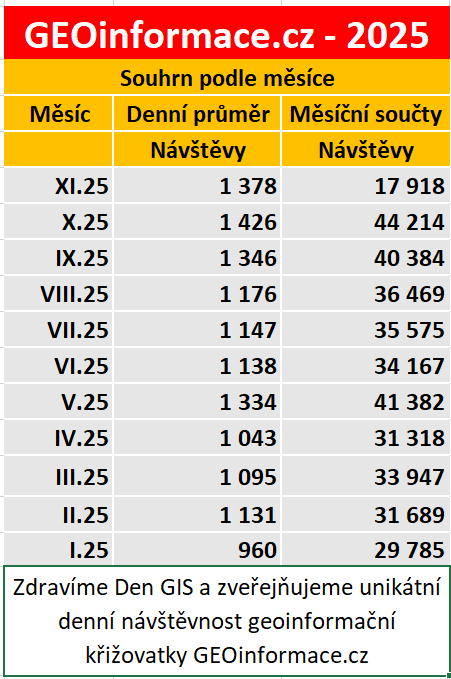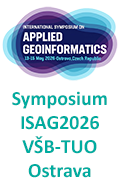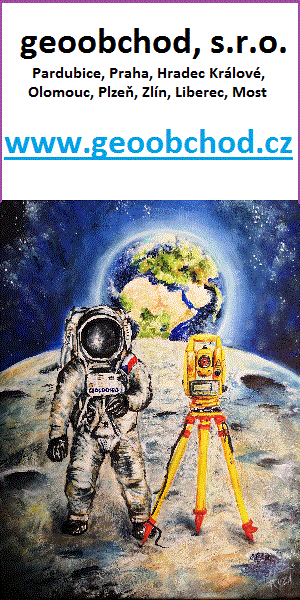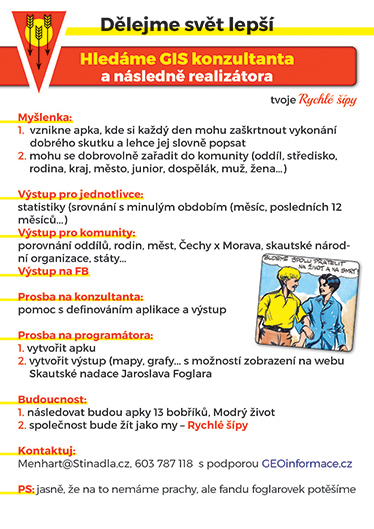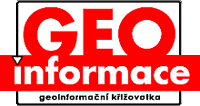zprávy
zdroje zpráv:Referent/ka ZKN
13.9.2021 10:09 ČÚZK - volná místa Zeměměřický úřad vypisuje výběrové řízení na místo Referent/ka ZKNReferent/ka ZKN
13.9.2021 10:09 ČÚZK - předpisy a opatření Zeměměřický úřadvypisuje výběrové řízení na místo
Referent/ka ZKN
Mapa roku 2020 (výsledky)
13.9.2021 8:27 GISportal.cz
Česká kartografická společnost v roce 2021 uspořádala v pořadí již 23. ročník soutěže Mapa roku. Odborná komise pro soutěž Mapa roku přihlášená kartografická díla vydaná na území České republiky v roce 2020 zhodnotila na svém červnovém zasedání a určila nominace a vítěze tohoto prestižního kartografického ocenění. Uzávěrka pro přihlášení kartografických děl a výsledků studentských prací byla 31. března […]
The post Mapa roku 2020 (výsledky) appeared first on GISportal.cz.
Mapa roku 2020 (výsledky)
13.9.2021 8:27 GISportal.cz
Česká kartografická společnost v roce 2021 uspořádala v pořadí již 23. ročník soutěže Mapa roku. Odborná komise pro soutěž Mapa roku přihlášená kartografická díla vydaná na území České republiky v roce 2020 zhodnotila na svém červnovém zasedání a určila nominace a vítěze tohoto prestižního kartografického ocenění. Uzávěrka pro přihlášení kartografických děl a výsledků studentských prací byla 31. března […]
The post Mapa roku 2020 (výsledky) appeared first on GISportal.cz.
Seequent to host geoscience community at 6th annual Lyceum virtual events
10.9.2021 22:11 GISCafe.com Webcasts-Webinars Lyceum 2021, Together Towards Tomorrow: virtual events on September 22 (global) and September 23-30 (regional events) celebrate the geoscience …Schneider Electric announces new capabilities for ecostruxure grid asset advisor
10.9.2021 22:09 GISCafe.com Webcasts-Webinars The latest release includes new functionality for enhanced asset analytics, new Asset Intelligence Library, and easier integration with IT/OT …URISA Announces 2021 Young Professional Scholarship Winners
10.9.2021 22:05 GISCafe.com Webcasts-Webinars Des Plaines, IL (September 9, 2021) URISA is pleased to announce that Josiah Burkett and Samantha Strang are the recipients of 2021 Dr. Marilyn …Worldwide Server Market Revenue Declined 2.5% Year Over Year in the Second Quarter of 2021, According to IDC
10.9.2021 16:18 GISCafe.com Webcasts-Webinars NEEDHAM, Mass. — (BUSINESS WIRE) — September 9, 2021 —According to the International Data Corporation (IDC) Worldwide Quarterly …
Další jednání KRS
10.9.2021 15:08 ČÚZK - předpisy a opatření Dne 15. září 2021 proběhne poprvé prezenčně jedenácté jednání Koordinační rady správců DMVS a DTM.Materiály Egger Cleaf pro TurboCAD a DAEX DESIGN
10.9.2021 13:20 ŠPINAR - softwareVážení zákazníci,
dovolujeme si Vám nabídnout
zdarma knihovnu materiálů Egger CLEAF pro programy TurboCAD 27 a DAEX DESIGN 22.
Aktualizujte si své knihovní prvky!
The post Materiály Egger Cleaf pro TurboCAD a DAEX DESIGN appeared first on ŠPINAR – software.
Materiály Egger Cleaf pro TurboCAD a DAEX DESIGN
10.9.2021 13:20 ŠPINAR - softwareVážení zákazníci,
dovolujeme si Vám nabídnout
zdarma knihovnu materiálů Egger CLEAF pro programy TurboCAD 27 a DAEX DESIGN 22.
Aktualizujte si své knihovní prvky!
The post Materiály Egger Cleaf pro TurboCAD a DAEX DESIGN appeared first on ŠPINAR – software.
Materiály Egger Cleaf pro TurboCAD a DAEX DESIGN
10.9.2021 13:20 ŠPINAR - software Vážení zákazníci,dovolujeme si Vám nabídnout
zdarma knihovnu materiálů Egger CLEAF pro programy TurboCAD 27 a DAEX DESIGN 22.
Aktualizujte si své knihovní prvky!
Acronis má nový software pro softwarovou ochranu malých firem
10.9.2021 12:07 ZeměměřičFirma Acronis, dlouhodobě se zabývající tvorbou zálohovacího softwaru, uvedla na trh novou verzi kybernetické ochrany pro malé kanceláře, živnostníky a domácí použití. Acronis Cyber Protect Home Office je novým názvem oceňovaného programu Acronis True Image, jež odráží integraci širokého spektra funkcí nutných ke komplexní ochraně před současnými kybernetickými riziky. Od roku 2017, kdy Acronis integroval anti-ransomwarovou […]
The post Acronis má nový software pro softwarovou ochranu malých firem appeared first on Zeměměřič.
DronEdge 2021 – 6. konference Aliance úspěšně za námi
10.9.2021 10:18 UAVADne 2.9.2021 se úspěšně konala již 6. konference Aliance pro bezpilotní letecký průmysl v kině Dlabačov v Praze. I za aktuálních epidemiologických opatření omezující se konání akcí s osobní účastí bylo na konferenci 110 návštěvníků a byla tak po velmi dlouhé době možnost se osobně setkat se zástupci průmyslu, vědy a výzkumu, leteckých autorit a […]
The post DronEdge 2021 – 6. konference Aliance úspěšně za námi appeared first on UAV Aliance pro bezpilotní letecký průmysl.
Earth from Space: Danube Delta
10.9.2021 10:00 ESA Observing the Earth
The Copernicus Sentinel-2 mission takes us over the Danube Delta – the second largest river delta in Europe.
Katastrálny portál
10.9.2021 10:00
ÚGKK SR
Aktuálna informácia ku grafickej časti (zobrazovanie máp) Katastrálneho portálu (www.katasterportal.sk)
Earth from Space: Danube Delta
10.9.2021 10:00 ESA Observing the Earth
The Copernicus Sentinel-2 mission takes us over the Danube Delta – the second largest river delta in Europe.
Kleos invests for future growth, expands Luxembourg headquarters
10.9.2021 9:00 GISCafe.com Webcasts-Webinars Kleos Space S.A (ASX: KSS, Frankfurt: KS1), a space-powered Radio Frequency Reconnaissance data-as-a-service (DaaS) company, is investing for future …Bluesky National Tree Map at the Root of Birmingham’s Urban Forest Master Plan
10.9.2021 9:00 GISCafe.com Webcasts-Webinars Leicestershire, UK, 07 September 2021 – An extract from a map that details the location and attributes of more than 300 million trees is being …Soutěž pro studenty technických a přírodovědeckých oborů. Cena Wernera von Siemense rozdělí 800 tisíc korun
10.9.2021 8:59 GeoBusinessSoutěž „Cena Wernera von Siemense“ pro studenty technických, přírodovědeckých a medicínských oborů a mladé vědce otevřela přihlašování do letošního čtyřiadvacátého ročníku. „Poznání a vzdělání je základem každého pokroku. Studentům, mladým vědcům a jejich pedagogům chceme ukázat, za jak důležitou jejich roli ve společnosti považujeme,“ uvedl k zahájení soutěže Eduard Palíšek, generální ředitel skupiny Siemens v České republice. Kandidáti se mohou přihlašovat prostřednictvím […]
The post Soutěž pro studenty technických a přírodovědeckých oborů. Cena Wernera von Siemense rozdělí 800 tisíc korun appeared first on GeoBusiness.
Soutěž pro studenty technických a přírodovědeckých oborů
10.9.2021 8:59 GeoBusinessSoutěž „Cena Wernera von Siemense“ pro studenty technických, přírodovědeckých a medicínských oborů a mladé vědce otevřela přihlašování do letošního čtyřiadvacátého ročníku. „Poznání a vzdělání je základem každého pokroku. Studentům, mladým vědcům a jejich pedagogům chceme ukázat, za jak důležitou jejich roli ve společnosti považujeme,“ uvedl k zahájení soutěže Eduard Palíšek, generální ředitel skupiny Siemens v České republice. Kandidáti se mohou přihlašovat prostřednictvím […]
The post Soutěž pro studenty technických a přírodovědeckých oborů appeared first on GeoBusiness.
Soutěž pro studenty technických a přírodovědeckých oborů
10.9.2021 8:59 GeoBusinessSoutěž „Cena Wernera von Siemense“ pro studenty technických, přírodovědeckých a medicínských oborů a mladé vědce otevřela přihlašování do letošního čtyřiadvacátého ročníku. „Poznání a vzdělání je základem každého pokroku. Studentům, mladým vědcům a jejich pedagogům chceme ukázat, za jak důležitou jejich roli ve společnosti považujeme,“ uvedl k zahájení soutěže Eduard Palíšek, generální ředitel skupiny Siemens v České republice. Kandidáti se […]
The post Soutěž pro studenty technických a přírodovědeckých oborů appeared first on GeoBusiness.
Nová verzia ZBGIS-Geoportálu
10.9.2021 7:20
ÚGKK SR
Vážení občania odborná i laická verejnosť, GKÚ nasadil novú verziu "ZBGIS-Geoportálu" - verzia 4.4.
Doplnené boli mnohé funkcie, ktoré môžete využívať a to: Porovnanie máp v témach Základná mapa, Kataster nehnuteľností, Terén a Archív, doplnená funkcia Meranie v 3D zobrazení tém Základná mapa, Kataster nehnuteľností a Terén, doplnená funkcia Rez vrstvami v 3D zobrazení tém Základná mapa, Kataster nehnuteľností a Terén, doplnenie podporovaných formátov Pridanie vrstvy zo súboru o GeoPackage, SpatialLite a SQLite, doplnenie možnosti zdieľania Zdieľanie mapy prostredníctvom QR kódu alebo HTML, doplnenie funkcie Zobraziť Vašu polohu v mobilnom zariadení s orientáciou zariadenia, Vytvorený nový formulár pre oznamovanie nedostatkov a žiadostí na odstránenie Referenčných geodetických bodov Žiadosti a oznámenia, doplnený atribút Ťiažové zrýchlenie (S-Gr95) vo vrstvách Referenčných geodetických bodov téma Geodetické základy, doplnené a aktualizované predvolené vrstvy Geológia (ŠGÚDŠ).
Prajeme Vám veľa úžitku z nových funkcií nášho najviac navštevovaného Portálu.
Intergeo 2021: The Gates Open For Intergeo 2021, Live In Hannover
9.9.2021 23:34 GISCafe.com Webcasts-Webinars Karlsruhe, 09.09.2021. INTERGEO live returns! With a comprehensive security strategy based on 3G rules, INTERGEO will take place in Hannover this …Three companies within the UAV industry were selected as winners of the Pitch The Press event taking place at CUAV Americas 2021: Emesent, BRINC Drones, and vHive
9.9.2021 20:14 GISCafe.com Webcasts-Webinars Pitch the Press is a unique opportunity for exhibitors to present their products to a group of editors and reporters looking for the most unique new …Pointivo Lands Ninth Patent Increasing Coverage of the Drone Analytics Market
9.9.2021 20:14 GISCafe.com Webcasts-Webinars ATLANTA, Sept. 09, 2021 (GLOBE NEWSWIRE) -- Pointivo, the leading software platform provider for asset inspection using AI and computer …Hesai Announces Distribution Agreement with LiDAR USA
9.9.2021 20:14 GISCafe.com Webcasts-Webinars SHANGHAI, Sept. 9, 2021 — (PRNewswire) — Hesai Technology Co., Ltd., a global leader in 3D LiDAR sensors, announced an agreement with …Woolpert Acquires Geospatial Partner Optimal GEO, Augments Lidar, Imagery Capabilities
9.9.2021 20:14 GISCafe.com Webcasts-Webinars This move unites like-minded geospatial leaders, enhancing their ability to support federal clients worldwide.DAYTON, Ohio, Sept. 9, 2021 — …
Fathom Launches LiveBy Local
9.9.2021 20:14 GISCafe.com Webcasts-Webinars -- New Service Provides Agents with Robust Suite of Hyperlocal Products to Help Them Drive Increased Transaction Volumes -CARY, N.C., Sept. 9, 2021 …
BlackSky Announces Completion of Merger with Osprey Technology Acquisition Corp.
9.9.2021 20:14 GISCafe.com Webcasts-Webinars BlackSky’s Common Stock to Commence Trading on NYSE Under the Ticker “BKSY”Gross proceeds to BlackSky totaled $283 million, combining funds …
Put your hack hat on, the 2nd Cassini Hackathon registrations are open!
9.9.2021 15:27 European GNSS Agency
The 2nd CASSINI Hackathon is set for 5-7 November 2021 and will tackle the challenge of connecting the Arctic with European satellite technologies. But where will the Hackathon take place? From Croatia to Iceland, this truly pan-European project is set to make an impact all across Europe!
The second CASSINI Hackathon will focus on the extraordinary region Arctic and is challenging you to develop ideas that help maintain safe passage at sea, assist life on land, and safeguard its native wildlife. With your help, we can protect, support and strengthen the Arctic using European space data, signals, and technologies.
The CASSINI Hackathons and Mentoring, initiated by the European Union and its space programmes, is a series of six hackathons that tackle global challenges using European space technologies. Now, in its second edition, this hackathon provides access to pre-processed Arctic data, on-demand training, and other valuable tools to help participants take on one of our three challenges. The best ideas will be awarded at both local and EU levels, and the overall winners will enter a six-month mentoring programme that includes 100 hours of customised expert mentoring.
Here’s what to expect: if you are a skilful innovator in Europe, you are invited to participate in the CASSINI Hackathon at one of our ten locations. Each hackathon location features its own unique set of experts, prizes, and additional special features. Once you select a location, it’s time for registration, team formation and ideation! Your team will choose to solve one of three challenges, all related to the theme of connecting the Arctic:
Safe passage at sea: design products, devices or services that enable container ships, cruise liners and fishing trawlers to navigate safely across our Nordic Seas. If you choose this challenge, you’ll be encouraged to dive into the areas of navigation route optimisation, extreme weather and sea ice warnings, the development and connectivity of future shipping lanes, and environmental disaster and emergency management.
Life on land: design products, devices or services that enable human societies, plants and wildlife to better adapt to the Arctic climate. If you choose this challenge, you’ll be encouraged to explore topics such as environmental monitoring and climate change mitigation, renewable energy advancements, environmental protection, and the improved connectivity for research stations in remote areas.
Caring for our wildlife: design products, devices or services that can help protect biodiversity and the natural habitat of wildlife in the Arctic. If you choose this challenge, you’ll be encouraged to focus on protecting marine biodiversity, understanding and forecasting migration routes, understanding and mitigating the effects of exploration and development on wildlife, and the impact of climate change on natural habitats.
Remember, no previous space experience is required. This is your chance to engage with the sector, even if it’s for the first time. The application process couldn’t be easier: Simply choose a challenge and decide how you’ll leverage EU space technologies to connect the Arctic. Register here: hackathons.cassini.eu/hackers
It’s your chance to become part of this exciting European initiative to promote EU Space technology and its many applications. Hack with a purpose and leverage EU space data, services and signals to access, understand and protect the Arctic!
More information: hackathons.cassini.eu
Media note: This feature can be republished without charge provided the European Union Agency for the Space Programme (EUSPA) is acknowledged as the source at the top or the bottom of the story. You must request permission before you use any of the photographs on the site. If you republish, we would be grateful if you could link back to the EUSPA website (http://www.euspa.europa.eu).
20210909 - VŘ Pověřenec
9.9.2021 13:03 ČÚZK - aktuality v resortu Oznámení o vyhlášení výběrového řízení na obsazení služebního místa odborný rada - Pověřenec pro ochranu osobních údajů.20210909 - VŘ Pověřenec
9.9.2021 13:03 ČÚZK - předpisy a opatření Český úřad zeměměřický a katastrální zveřejnil novou aktualitu: Oznámení o vyhlášení výběrového řízení na obsazení služebního místa odborný rada - Pověřenec pro ochranu osobních údajů.Odborný rada - Pověřenec pro ochranu osobních údajů
9.9.2021 12:56 ČÚZK - předpisy a opatření Český úřad zeměměřický a katastrálnívypisuje výběrové řízení na místo
Odborný rada - Pověřenec pro ochranu osobních údajů
Odborný rada - Pověřenec pro ochranu osobních údajů
9.9.2021 12:56 ČÚZK - volná místa Český úřad zeměměřický a katastrální vypisuje výběrové řízení na místo Odborný rada - Pověřenec pro ochranu osobních údajůOdborný rada - Pověřenec pro ochranu osobních údajů
9.9.2021 12:56 ČÚZK /Urady/Cesky-urad-zememericky-a-katastralni/Uredni-deska/Oznameni-a-jina-uredni-sdeleni/Volna-mista/DMS/Odborny-rada-Poverenec-pro-ochranu-osobnich-udajCo umí nová verze ArcGIS Online Map Viewer
9.9.2021 11:08 GeoBusinessLucie Patková z firmy Arcdata Praha představila na webináři novou generaci softwaru ArcGIS Online Map Viewer. Ten se předtím jmenoval Map Viewer Beta. Software má nové uživatelské prostředí, ale také novou Smart Mapping symbologii, možnosti změny stylů rastrových dat (Imagery Layers). Dozvíte se také o tvorbě interaktivních grafů, konfiguraci vyskakovacích oken nebo vytváření skic. Na závěr Lucie […]
The post Co umí nová verze ArcGIS Online Map Viewer appeared first on GeoBusiness.
Co umí nová verze ArcGIS Online Map Viewer
9.9.2021 11:08 GeoBusinessLucie Patková z firmy Arcdata Praha představila na webináři novou generaci softwaru ArcGIS Online Map Viewer. Ten se předtím jmenoval Map Viewer Beta. Software má nové uživatelské prostředí, ale také novou Smart Mapping symbologii, možnosti změny stylů rastrových dat (Imagery Layers). Dozvíte se také o tvorbě interaktivních grafů, konfiguraci vyskakovacích oken nebo vytváření skic. Na […]
The post Co umí nová verze ArcGIS Online Map Viewer appeared first on GeoBusiness.
Firma Arcdata Praha spustila registraci na virtuální konferenci GIS Esri v ČR
9.9.2021 10:57 GeoBusinessOrganizátor listopadové konference GIS Esri v ČR, která se loni poprvé po dvou dekádách musela uskutečnit pouze ve virtuální podobě, otevřel registrační formulář na letošní konferenci. Podobně jako loni se akce uskuteční ve virtuální podobě, protože nikdo netuší, jak se vyvine situace s variantou delta covid-19. Datum letošního ročníku GIS Esri v ČR je 2. […]
The post Firma Arcdata Praha spustila registraci na virtuální konferenci GIS Esri v ČR appeared first on GeoBusiness.
Firma Arcdata Praha spustila registraci na virtuální konferenci GIS Esri v ČR
9.9.2021 10:57 GeoBusinessOrganizátor listopadové konference GIS Esri v ČR, která se loni poprvé po dvou dekádách musela uskutečnit pouze ve virtuální podobě, otevřel registrační formulář na letošní konferenci. Podobně jako loni se akce uskuteční ve virtuální podobě, protože nikdo netuší, jak se vyvine situace s variantou delta covid-19. Datum letošního ročníku GIS Esri v ČR je 2. a 3. listopadu 2021. https://www.arcdata.cz/zpravy-a-akce/akce/konference
The post Firma Arcdata Praha spustila registraci na virtuální konferenci GIS Esri v ČR appeared first on GeoBusiness.
CADfórum 2021. BIM bude hlavním tématem prvního dne konference
9.9.2021 10:31 ZeměměřičPodzimní dvoudenní konference CADfórum se letos koná v Brně ve dnech 21. a 22. září. První den bude zaměřen na BIM, automatizaci projektování a výstavby. Akci pořádá firma Arkance Systems (CAD Studio 1991-2021). 1. den – Stavebnictví, BIM (21. 9.) – Automatizace projektování a výstavby Hlavní sál (společné) 9:00 – 9:30 Registrace účastníků konference 9:30 – 9:35 Společná zahajovací sekce Slavnostní zahájení konference […]
The post CADfórum 2021. BIM bude hlavním tématem prvního dne konference appeared first on Zeměměřič.
CADfórum 2021. První den bude zaměřen na BIM a stavebnictví
9.9.2021 10:00 BIM NewsOsmnáctý ročník akce jménem CADfórum, pořádané firmou Arkance Systems (CAD Studio 1991-2021), se letos uskuteční v Brně ve dnech 21. a 22. září. Konference je i tentokrát dvoudenní. První den je zaměřen na stavebnictví, druhý den bude věnován strojírenství. 1. den – Stavebnictví, BIM (21. 9.) – Automatizace projektování a výstavby Hlavní sál (společné) 9:00 […]
The post CADfórum 2021. První den bude zaměřen na BIM a stavebnictví appeared first on BIM News.
Konference Coding4Good nabízí několik inspirací, jak mohou vývojáři a technologie zlepšit současný svět (pozvánka)
9.9.2021 8:56 GISportal.cz
Vývoj technologií a software mění posledních několik desetiletí výrazně náš svět. Současně ale lidstvo čelí velkému množství výzev: od globálního oteplování, přes vymírání druhů až po zákeřné pandemie. Jak můžeme těmto výzvám čelit s pomocí vývojářských dovedností se snaží na několika případových studiích ukázat odborná konference Coding4Good. Dozvíte se na ní, jak funguje mezinárodní filantropický […]
The post Konference Coding4Good nabízí několik inspirací, jak mohou vývojáři a technologie zlepšit současný svět (pozvánka) appeared first on GISportal.cz.
Konference Coding4Good nabízí několik inspirací, jak mohou vývojáři a technologie zlepšit současný svět (pozvánka)
9.9.2021 8:56 GISportal.cz
Vývoj technologií a software mění posledních několik desetiletí výrazně náš svět. Současně ale lidstvo čelí velkému množství výzev: od globálního oteplování, přes vymírání druhů až po zákeřné pandemie. Jak můžeme těmto výzvám čelit s pomocí vývojářských dovedností se snaží na několika případových studiích ukázat odborná konference Coding4Good. Dozvíte se na ní, jak funguje mezinárodní filantropický […]
The post Konference Coding4Good nabízí několik inspirací, jak mohou vývojáři a technologie zlepšit současný svět (pozvánka) appeared first on GISportal.cz.
Konferenci GIS Esri v ČR (přihlašování)
9.9.2021 8:17 GISportal.cz
Přihláška na Konferenci GIS Esri v ČR byla právě spuštěna. Přečtěte si podrobnosti a pokud máte navíc i nějaký zajímavý projekt, určitě neváhejte a využijte jednu z možností prezentace. Jaká letošní konference bude a kdo se může přihlásit? Vzhledem k okolnostem jsme se rozhodli konferenci uspořádat opět virtuální formou, což Vám mimo jiné zajistí, že […]
The post Konferenci GIS Esri v ČR (přihlašování) appeared first on GISportal.cz.
Konferenci GIS Esri v ČR (přihlašování)
9.9.2021 8:17 GISportal.cz
Přihláška na Konferenci GIS Esri v ČR byla právě spuštěna. Přečtěte si podrobnosti a pokud máte navíc i nějaký zajímavý projekt, určitě neváhejte a využijte jednu z možností prezentace. Jaká letošní konference bude a kdo se může přihlásit? Vzhledem k okolnostem jsme se rozhodli konferenci uspořádat opět virtuální formou, což Vám mimo jiné zajistí, že […]
The post Konferenci GIS Esri v ČR (přihlašování) appeared first on GISportal.cz.
Pynwheel Unveils 3D Maps for Interactive Property Map Solution
9.9.2021 0:53 GISCafe.com Webcasts-Webinars New Feature to Further Enhance Multifamily Property Websites with Pynwheel MapsDENVER, Sept. 8, 2021 — (PRNewswire) —
…
Agrowing and Senseacre Labs partner for enhancing aerial remote sensing from NDVI to Deep Learning AI Precision Agriculture" solutions in India
9.9.2021 0:53 GISCafe.com Webcasts-Webinars Senseacre Labs of India Agrowing of Israel enter a collaboration to enhance aerial precision agriculture in India with the next level of deep …CoreLogic Estimates $16 Billion to $24 Billion in Insured and Uninsured Flood Losses in the Northeast from Tropical Storm Ida
8.9.2021 21:59 GISCafe.com Webcasts-Webinars —One of the worst flooding events in this region underscores importance for community resilience ahead of increasingly severe natural …Nové číslo Zpravodaje ČKS 3/2021
8.9.2021 21:54 Česká kartografická společnost Přinášíme letošní třetí Zpravodaj České kartografické společnosti. Prolistovat si jej můžete online. Účastníci 24. kartografické konference v Ostravě si navíc u registrace mohou vyzvednout tištěnou verzi. Přejeme příjemné čtení!Airspace Link Announces Partnership with the City of Las Vegas to Enable Safer Drone Operations and Laying the Groundwork for Scalable Commercial Applications
8.9.2021 20:58 GISCafe.com Webcasts-Webinars DETROIT, Sept. 8, 2021 — (PRNewswire) — Airspace Link, Inc., a leading provider of drone mapping and solution software, announced it …20210908 - Změny VFK v nové verzi ISKN 9.2
8.9.2021 18:13 ČÚZK - předpisy a opatření V souvislosti s instalací nové verze ISKN 9.2 dojde ke změně ve struktuře výměnného formátu ISKN. Nová verze ponese označení 5.6. Předpokládaný termín instalace je 5.11.202120210908 - Změny VFK v nové verzi ISKN 9.2
8.9.2021 18:13 ČÚZK - Výměnný formát ISKN V souvislosti s instalací nové verze ISKN 9.2 dojde ke změně ve struktuře výměnného formátu ISKN. Nová verze ponese označení 5.6. Předpokládaný termín instalace je 5.11.202120210908 - Změny VFK v nové verzi ISKN 9.2
8.9.2021 18:13 ČÚZK - Výměnný formát ISKN V souvislosti s instalací nové verze ISKN 9.2 dojde ke změně ve struktuře výměnného formátu ISKN. Nová verze ponese označení 5.6. Předpokládaný termín instalace je 5.11.202120210908 - Změny VFK v nové verzi ISKN 9.2
8.9.2021 18:13 ČÚZK - Výměnný formát ISKN V souvislosti s instalací nové verze ISKN 9.2 dojde ke změně ve struktuře výměnného formátu ISKN. Nová verze ponese označení 5.6. Předpokládaný termín instalace je 5.11.202120210908 - Změny VFK v nové verzi ISKN 9.2
8.9.2021 18:13 ČÚZK - Výměnný formát ISKN V souvislosti s instalací nové verze ISKN 9.2 dojde ke změně ve struktuře výměnného formátu ISKN. Nová verze ponese označení 5.6. Předpokládaný termín instalace je 5.11.202120210908 - Změny VFK v nové verzi ISKN 9.2
8.9.2021 18:13 ČÚZK - Výměnný formát ISKN V souvislosti s instalací nové verze ISKN 9.2 dojde ke změně ve struktuře výměnného formátu ISKN. Nová verze ponese označení 5.6. Předpokládaný termín instalace je 5.11.202120210908 - Změny VFK v nové verzi ISKN 9.2
8.9.2021 17:53 ČÚZK /Katastr-nemovitosti/Poskytovani-udaju-z-KN/Vymenny-format-KN/Podrobne-informace-VF-ISKN/Archiv-podrobnych-informaci/20210908-Zmeny-VFK-v-nove-verzi-ISKN-9-220210908 - Změny VFK v nové verzi ISKN 9.2
8.9.2021 17:53 ČÚZK - předpisy a opatření Český úřad zeměměřický a katastrální zveřejnil novou aktualitu: V souvislosti s instalací nové verze ISKN 9.2 dojde ke změně ve struktuře výměnného formátu ISKN. Nová verze ponese označení 5.6. Předpokládaný termín instalace je 5.11.2021Fortem Technologies and URSA Announce Webinar: Defeating the Most Dangerous Drones
8.9.2021 17:44 GISCafe.com Webcasts-Webinars Pleasant Grove, Utah, Sept. 07, 2021 (GLOBE NEWSWIRE) -- Fortem Technologies, the leader in airspace security and defense for detecting and …NOAA Awards Tetra Tech $49 Million Coastal Geospatial Contract
8.9.2021 17:44 GISCafe.com Webcasts-Webinars PASADENA, Calif. — (BUSINESS WIRE) — September 8, 2021 —Tetra Tech, Inc. (NASDAQ: TTEK), a leading provider of high-end …
Inmarsat’s Velaris Connectivity Solution to Unlock Unlimited Possibilities of Fast-growing UAV Industry
8.9.2021 17:44 GISCafe.com Webcasts-Webinars LONDON — (BUSINESS WIRE) — September 8, 2021 —Ground-breaking new offering will safely integrate drones into managed airspace, …
Cupix Integration with Procore Delivers Industry’s First Location-Based Virtual Job Site Navigation
8.9.2021 17:44 GISCafe.com Webcasts-Webinars Integration with CupixWorks 3D Digital Twin Platform Works Seamlessly within the Procore Platform with No Additional Training RequiredSAN JOSE, …
VR do 26.10. rada/odborný rada – opravy chyb v KN
8.9.2021 16:54 ČÚZK - předpisy a opatření Katastrální úřad pro hlavní město Prahu - Katastrální pracoviště Praha VR do 1.10. rada/odborný rada – opravy chyb v KN Ředitelka úřadu vyhlašuje výběrové řízení na systemizované služební místo:rada/odborný rada – opravy chyb
VR do 19.11. referent KN – zápis do protokolu řízení V a Z
8.9.2021 16:54 ČÚZK /Urady/Katastralni-urady/Katastralni-urady/Katastralni-urad-pro-hlavni-mesto-Prahu/O-uradu/Aktuality/VR-do-1-10-rada-odborny-rada-–-opravy-chyb-v-KNVR do 1.10. rada/odborný rada – opravy chyb v KN
8.9.2021 16:54 ČÚZK /Urady/Katastralni-urady/Katastralni-urady/Katastralni-urad-pro-hlavni-mesto-Prahu/O-uradu/Aktuality/VR-do-1-10-rada-odborny-rada-–-opravy-chyb-v-KNVR do 26.10. rada/odborný rada – opravy chyb v KN
8.9.2021 16:54 ČÚZK /Urady/Katastralni-urady/Katastralni-urady/Katastralni-urad-pro-hlavni-mesto-Prahu/O-uradu/Aktuality/VR-do-1-10-rada-odborny-rada-–-opravy-chyb-v-KNVR do 1.10. rada/odborný rada – opravy chyb v KN
8.9.2021 16:54 ČÚZK - předpisy a opatření Katastrální úřad pro hlavní město Prahu - Katastrální pracoviště Praha VR do 1.10. rada/odborný rada – opravy chyb v KN Ředitelka úřadu vyhlašuje výběrové řízení na systemizované služební místo:Rada/odborný rada – opravy chyb v KN
VR do 19.11. referent KN – zápis do protokolu řízení V a Z
8.9.2021 16:54 ČÚZK - předpisy a opatření Katastrální úřad pro hlavní město Prahu VR do 1.10. rada/odborný rada – opravy chyb v KN Ředitelka úřadu vyhlašuje výběrové řízení na systemizované služební místo:referent KN – zápis do protokolu řízení V a Z
VR do 29.9. vrchní referent/rada – kontrola listin určených k záznamu
8.9.2021 16:49 ČÚZK /Urady/Katastralni-urady/Katastralni-urady/Katastralni-urad-pro-hlavni-mesto-Prahu/O-uradu/Aktuality/VR-do-29-9-vrchni-referent-rada-–-kontrola-listinVR do 29.9. vrchní referent/rada – kontrola listin určených k záznamu
8.9.2021 16:49 ČÚZK - předpisy a opatření Katastrální úřad pro hlavní město Prahu - Katastrální pracoviště Praha VR do 29.9. VR na služební místo vrchní referent/rada – kontrola listin určených k záznamu Ředitelka úřadu vyhlašuje výběrové řízení na systemizované služební místo:Vrchní referent/rada – kontrola listin určených k záznamu
New angle on reflected satnav yields sharper sea tracking
8.9.2021 16:48 ESA Navigation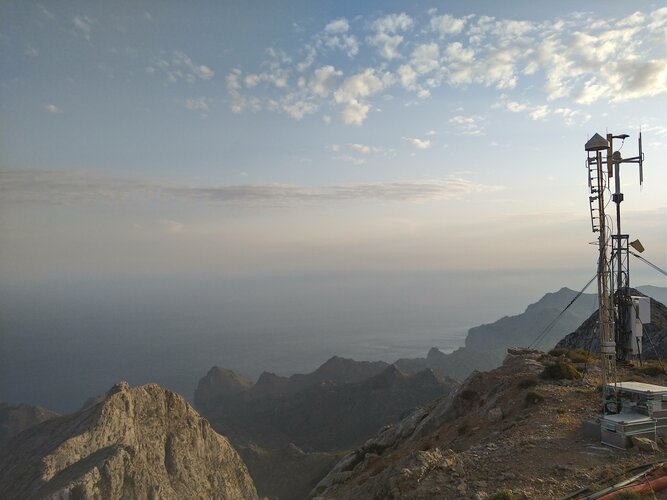
An experimental satellite navigation receiver station high atop Spain’s Mallorca island has opened up a novel view of the ever-changing face of the sea. By picking up satnav signals from the far horizon as they bounce off ocean waves, the receivers are able to measure sea surface height down to a scale of centimetres.
VR do 30.9. rada/odborný rada – vedoucí oddělení potvrzování geometrických plánů
8.9.2021 16:43 ČÚZK /Urady/Katastralni-urady/Katastralni-urady/Katastralni-urad-pro-hlavni-mesto-Prahu/O-uradu/Aktuality/VR-do-30-9-rada-odborny-rada-–-vedouci-oddeleni-pVR do 30.9. rada/odborný rada – vedoucí oddělení potvrzování geometrických plánů
8.9.2021 16:43 ČÚZK - předpisy a opatření Katastrální úřad pro hlavní město Prahu - Katastrální pracoviště Praha VR na služební místo rada/odborný rada – vedoucí oddělení potvrzování geometrických plánů Ředitelka úřadu vyhlašuje výběrové řízení na systemizované služební místo:Rada/odborný rada – vedoucí oddělení potvrzování geometrických plánů
rada/odborný rada – opravy chyb v KN
8.9.2021 16:33 ČÚZK - volná místa Katastrální úřad pro hlavní město Prahu Katastrální pracoviště Praha vypisuje výběrové řízení na místo rada/odborný rada – opravy chyb v KNrada/odborný rada – opravy chyb v KN
8.9.2021 16:33 ČÚZK - předpisy a opatření Katastrální úřad pro hlavní město Prahu Katastrální pracoviště Prahavypisuje výběrové řízení na místo
rada/odborný rada – opravy chyb v KN
vrchní referent/rada – kontrola listin určených k záznamu
8.9.2021 16:28 ČÚZK - předpisy a opatření Katastrální úřad pro hlavní město Prahu Katastrální pracoviště Prahavypisuje výběrové řízení na místo
vrchní referent/rada – kontrola listin určených k záznamu
vrchní referent/rada – kontrola listin určených k záznamu
8.9.2021 16:28 ČÚZK - volná místa Katastrální úřad pro hlavní město Prahu Katastrální pracoviště Praha vypisuje výběrové řízení na místo vrchní referent/rada – kontrola listin určených k záznamurada/odborný rada – vedoucí oddělení potvrzování geometrických plánů
8.9.2021 16:24 ČÚZK - volná místa Katastrální úřad pro hlavní město Prahu Katastrální pracoviště Praha vypisuje výběrové řízení na místo rada/odborný rada – vedoucí oddělení potvrzování geometrických plánůrada/odborný rada – vedoucí oddělení potvrzování geometrických plánů
8.9.2021 16:24 ČÚZK - předpisy a opatření Katastrální úřad pro hlavní město Prahu Katastrální pracoviště Prahavypisuje výběrové řízení na místo
rada/odborný rada – vedoucí oddělení potvrzování geometrických plánů
rada/odborný rada – vedoucí oddělení potvrzování geometrických plánů
8.9.2021 16:24 ČÚZK /Urady/Katastralni-urady/Katastralni-urady/Katastralni-urad-pro-hlavni-mesto-Prahu/Uredni-deska/Oznameni-a-jina-uredni-sdeleni/Volna-mista/DMS/rada-odborny-rada-–-vedouci-oddeleni-potvrzovaniVÝBĚROVÉ ŘÍZENÍ - Referent KN – vedení DKM, vedení katastrální mapy
8.9.2021 15:38 ČÚZK - předpisy a opatření Katastrální úřad pro hlavní město Prahu výběrové řízení na místo: Referent KN – vedení DKM, vedení katastrální mapy Ředitelka úřadu vyhlašuje výběrové řízení na systemizované služební místo:Referent KN – vedení DKM, vedení katastrální mapy
VR do 22.09. Referent KN – vedení DKM, vedení katastrální mapy
8.9.2021 15:38 ČÚZK /Urady/Katastralni-urady/Katastralni-urady/Katastralni-urad-pro-hlavni-mesto-Prahu/O-uradu/Aktuality/VYBEROVE-RIZENI-Referent-KN-–-vedeni-DKM,-vedeniVR do 22.09. Referent KN – vedení DKM, vedení katastrální mapy
8.9.2021 15:38 ČÚZK - předpisy a opatření Katastrální úřad pro hlavní město Prahu výběrové řízení na místo: Referent KN – vedení DKM, vedení katastrální mapy Ředitelka úřadu vyhlašuje výběrové řízení na systemizované služební místo:Referent KN – vedení DKM, vedení katastrální mapy
VÝBĚROVÉ ŘÍZENÍ - Referent KN – vedení DKM, vedení katastrální mapy
8.9.2021 15:38 ČÚZK /Urady/Katastralni-urady/Katastralni-urady/Katastralni-urad-pro-hlavni-mesto-Prahu/O-uradu/Aktuality/VYBEROVE-RIZENI-Referent-KN-–-vedeni-DKM,-vedeniReferent KN – vedení DKM, vedení katastrální mapy, PT 10
8.9.2021 15:06 ČÚZK - předpisy a opatření Katastrální úřad pro hlavní město Prahuvypisuje výběrové řízení na místo
Referent KN – vedení DKM, vedení katastrální mapy, PT 10
Referent KN – vedení DKM, vedení katastrální mapy, PT 10
8.9.2021 15:06 ČÚZK - volná místa Katastrální úřad pro hlavní město Prahu vypisuje výběrové řízení na místo Referent KN – vedení DKM, vedení katastrální mapy, PT 10Referent KN – vedení DKM, vedení katastrální mapy, PT 10
8.9.2021 15:06 ČÚZK /Urady/Katastralni-urady/Katastralni-urady/Katastralni-urad-pro-hlavni-mesto-Prahu/Volna-mista/DMS/Referent-KN-–-vedeni-DKM,-vedeni-katastralni-mapy,EC Commissioner Breton visits ESA-ESTEC
8.9.2021 11:33 ESA Navigation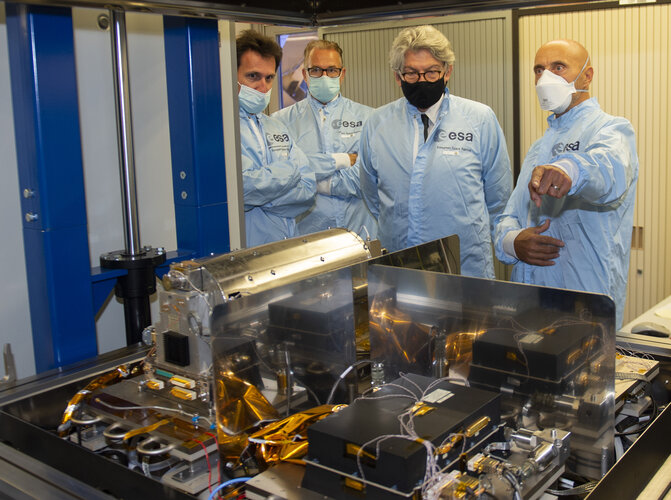 Image:
EC Commissioner Breton visits ESA-ESTEC
Image:
EC Commissioner Breton visits ESA-ESTEC
EC Commissioner Breton visits ESTEC
8.9.2021 11:33 ESA Navigation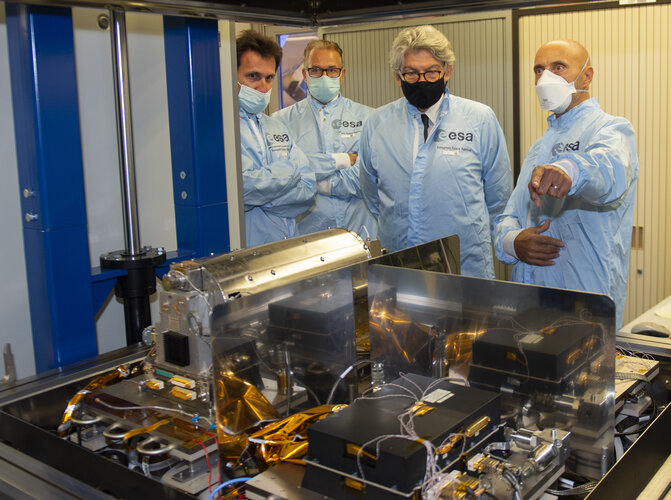 Image:
EC Commissioner Breton visits ESTEC
Image:
EC Commissioner Breton visits ESTEC
Registrujte se na 1. INSPIRE ESPUS konferenci
8.9.2021 9:23 CENIA - národní geoportál INSPIRE Aký je stav a výhľady možností harmonizovaného zdieľania geodát prostredníctvom legislatívy INSPIRE na Slovensku, v Českej republike a z perspektívy Európskej komisie? Bude možné nájsť a využiť synergiu s eGovernment aktivitami na podporu ich využitia? Akým spôsobom prispieva projekt Efektívna správa priestorových informácií a služieb (ESPUS) k dostupnejším a kvalitnejším priestorovým údajom? Ak...KONFERENCE INSPIRUJME SE... UŽIVATELI – PREZENČNĚ I ONLINE
8.9.2021 9:09 CENIA - národní geoportál INSPIRE Česká informační agentura životního prostředí a Ministerstvo životného prostredia Slovenskej republiky Vás zvou na 12. ročník konference Inspirujme se... uživateli, který se letos uskuteční ve dnech 5. – 6. 10. 2021 v Praze. Pandemie COVID-19 zásadně ovlivnila možnosti pořádání akcí a i přesto, že se vše pomalu začíná vracet do běžného režimu, rozhodli jsme se letošní konferenci upořádat jako...Mercedes-Benz deploys HERE HD Live Map for DRIVE PILOT system
8.9.2021 9:00 GISCafe.com Webcasts-Webinars HERE is among the world’s first companies to provide an HD map for commercial production vehicles with Level 3 automated driving …Geoslam Tour po ČR (TZ)
8.9.2021 8:15 GISportal.cz
Společnosti Geoslam a 3Gon Positioning Vás zvou na pouť po přírodních a kulturních památkách České republiky. V týdnu od 13. do 17. září Vás zvou na kteroukoli z lokalit, která se Vám bude v nabídce líbit a bude pro Vás časově dostupná. Tyto lokality budou skenovat nejnovější technologií ručních mobilních skenerů od společnosti Geoslam: se […]
The post Geoslam Tour po ČR (TZ) appeared first on GISportal.cz.
Vít Suchánek z ČÚZK získal ocenění eOsobnost roku 2021 za celkový přínos
8.9.2021 5:25 ZeměměřičTaké v letošním roce ocenili čtenáři časopisu Egovernment ty, kteří se svojí prací zasloužili o elektronizaci veřejné správy v České republice. Ocenění „eOsobnost roku 2021 za celkový přínos“ si tentokrát odnesl ing. Vít Suchánek, který svůj pracovní život zasvětil práci pro Český úřad zeměměřický a katastrální, stál u zlomových okamžiků jeho IT a svojí prací vždy podporoval rozvoj elektronizace tohoto úřadu. […]
The post Vít Suchánek z ČÚZK získal ocenění eOsobnost roku 2021 za celkový přínos appeared first on Zeměměřič.
Hexagon partners with RapidSOS to provide life-saving emergency data to first responders
8.9.2021 0:55 Hexagon Safety & Infrastructure Hexagon’s HxGN OnCall Dispatch software recognized as RapidSOS ReadyPřenosný monitor Dell C1422H
7.9.2021 22:52 GeoBusinessPrvní přenosný monitor od firmy Dell má úhlopříčku 14 palců a můžete tak po snadném připojení k notebooku přes USB-C využívat druhou obrazovku, například k prezentacím nebo na cestách. Hmotnost monitoru je něco málo přes půl kilogramu a tenké provedení (méně než 6,5 mm v nejtenčím bodě). Monitor používá zobrazovací technologii IPS s rozlišením Full HD při poměru stran 16 : 9 (1920 x 1080 […]
The post Přenosný monitor Dell C1422H appeared first on GeoBusiness.
Přenosný monitor Dell C1422H
7.9.2021 22:52 GeoBusinessPrvní přenosný monitor od firmy Dell má úhlopříčku 14 palců a můžete tak po snadném připojení k notebooku přes USB-C využívat druhou obrazovku, například k prezentacím nebo na cestách. Hmotnost monitoru je něco málo přes půl kilogramu a tenké provedení (méně než 6,5 mm v nejtenčím bodě). Monitor používá zobrazovací technologii IPS s rozlišením Full […]
The post Přenosný monitor Dell C1422H appeared first on GeoBusiness.
Hexagon revolutionises autonomous reality capture with the launch of the Leica BLK ARC and Leica BLK2FLY
7.9.2021 19:43 GISCafe.com Webcasts-Webinars NACKA STRAND, Sweden, Sept. 7, 2021 — (PRNewswire) — Hexagon AB, a global leader in digital reality solutions, today announced the …Omni Design and LeddarTech Collaborate to Accelerate Mass Market Deployment of LiDAR for ADAS and Autonomous Vehicles
7.9.2021 18:43 GISCafe.com Webcasts-Webinars SAN JOSE, Calif. and QUEBEC CITY — (BUSINESS WIRE) — September 7, 2021 —Omni Design Technologies, a leading provider of …
Terrafugia Inc. Launches New Brand and Commercial UAV
7.9.2021 18:43 GISCafe.com Webcasts-Webinars Commaris debuts flagship product at Commercial UAV Expo in Las VegasLAS VEGAS — (BUSINESS WIRE) — September 7, 2021 —
Terrafugia …
Innoviz Technologies to Demonstrate High-Performance LiDAR Technology at IAA MOBILITY Show in Munich
7.9.2021 16:28 GISCafe.com Webcasts-Webinars TEL AVIV, Israel, Sept. 7, 2021 — (PRNewswire) — Innoviz Technologies (Nasdaq: INVZ), a leading provider of …BlackSky Awarded Five Year $30 Million NGA Contract
7.9.2021 16:28 GISCafe.com Webcasts-Webinars Geospatial intelligence company leverages advanced Spectra AI platform to deliver automated methods for monitoring global economic activityHERNDON, …
U.S. Home Price Index Annual Growth Reaches All-Time High in July, CoreLogic Reports
7.9.2021 16:28 GISCafe.com Webcasts-Webinars In July, the 12-month rise in U.S. Home Price Index reaches record-setting 18%Areas with lower population density remain in high demand; lead the …
Planet Collaborates with Google Earth to Offer NICFI Tropical Forest Basemaps in Google Earth Engine
7.9.2021 16:28 GISCafe.com Webcasts-Webinars SAN FRANCISCO — (BUSINESS WIRE) — September 7, 2021 —Planet, a leading provider of daily data and insights about Earth, today …
AgEagle Launches New Industry Standard for High Performance, High Resolution Multispectral Sensors for Commercial Drone Applications
7.9.2021 16:28 GISCafe.com Webcasts-Webinars WICHITA, Kan., Sept. 07, 2021 (GLOBE NEWSWIRE) -- AgEagle Aerial Systems Inc. (NYSE American: UAVS) (“AgEagle” or the “Company”), …VELARY to Launch 4-Hour Flight UAV Wildfire Solutions at Commercial UAV Expo Americas
7.9.2021 16:28 GISCafe.com Webcasts-Webinars Sustainable aircraft debuted at expo reduce risk to first responders by flying day and night, operating in low visibility, and carry 55+ lbs in …Luokung Announces eMapGo to Provide Autonomous Driving Data Services for Zenseact
7.9.2021 16:28 GISCafe.com Webcasts-Webinars BEIJING, Sept. 7, 2021 — (PRNewswire) — Luokung Technology Corp. (NASDAQ: LKCO) ("Luokung" or the "Company"), a leading …24. kartografická konference v Ostravě, podrobný program
7.9.2021 16:06 GeoBusinessV pořadí 24. kartografická konference se koná ve dnech 8. až 10. září 2021 v Ostravě. V programu jsou workshopy, referáty i postery. 1. den – středa 8. září 2021 Workshop 1 – Tvorba map pro orientační běh L. Krtička (Ostravská univerzita): Jak mapy pro orientační běh vznikají? Co všechno obsahují? Jaký se používá software a mapové podklady? Jak se mapuje v terénu? Workshop zaměřený […]
The post 24. kartografická konference v Ostravě, podrobný program appeared first on GeoBusiness.
24. kartografická konference v Ostravě, podrobný program
7.9.2021 16:06 GeoBusinessV pořadí 24. kartografická konference se koná ve dnech 8. až 10. září 2021 v Ostravě. V programu jsou workshopy, referáty i postery. 1. den – středa 8. září 2021 Workshop 1 – Tvorba map pro orientační běh L. Krtička (Ostravská univerzita): Jak mapy pro orientační běh vznikají? Co všechno obsahují? Jaký se používá software […]
The post 24. kartografická konference v Ostravě, podrobný program appeared first on GeoBusiness.
20210903_Rada / odborný rada – informatik
7.9.2021 10:22 ČÚZK /Urady/Katastralni-urady/Katastralni-urady/Katastralni-urad-pro-Stredocesky-kraj/Katastralni-pracoviste/KP-Benesov/O-uradu/Aktuality/20210113_odborny-rada,-reditel-Katastralniho-p-(3)20210903_Odborný rada oddělení právních vztahů k nemovitostem
7.9.2021 10:22 ČÚZK - předpisy a opatření Katastrální úřad pro Středočeský kraj - Katastrální pracoviště Benešov Vyhlášení výběrového řízení: Odborný rada oddělení právních vztahů k nemovitostem V části "Úřední deska", v sekci "Oznámení a jiná úřední sdělení" bylo vystaveno "Oznámení o vyhlášení výběrového řízení na obsazení služebního místa Odborný rada oddělení právních vztahů k nemovitostem"20210903_Rada / odborný rada – informatik
7.9.2021 10:22 ČÚZK - předpisy a opatření Katastrální úřad pro Středočeský kraj - Katastrální pracoviště Benešov Vyhlášení výběrového řízení: Rada / odborný rada – informatik V části "Úřední deska", v sekci "Oznámení a jiná úřední sdělení" bylo vystaveno "Oznámení o vyhlášení výběrového řízení na obsazení služebního místa Rada / odborný rada – informatik"Rada / odborný rada – informatik
7.9.2021 10:20 ČÚZK - volná místa Katastrální úřad pro Středočeský kraj - Katastrální pracoviště Benešov vypisuje výběrové řízení na místo Rada / odborný rada – informatikRada / odborný rada – informatik
7.9.2021 10:20 ČÚZK - předpisy a opatření Katastrální úřad pro Středočeský kraj - Katastrální pracoviště Benešovvypisuje výběrové řízení na místo Rada / odborný rada – informatik
Rada / odborný rada – informatik
Rada / odborný rada – informatik
7.9.2021 10:20 ČÚZK /Urady/Katastralni-urady/Katastralni-urady/Katastralni-urad-pro-Stredocesky-kraj/Uredni-deska/Oznameni-a-jina-uredni-sdeleni/Volna-mista/Rada-odborny-rada-–-informatikPřihlašování na Konferenci GIS Esri v ČR je spuštěno
7.9.2021 9:24 ARCDATAJaká letošní konference bude a kdo se na ní může přihlásit?
Vzhledem k okolnostem jsme se rozhodli konferenci uspořádat opět virtuální formou, což vám mimo jiné zajistí, že stihnete opravdu každou přednášku či workshop, o který budete mít zájem. Vedle živě přenášených sekcí a předtočených uživatelských přednášek se můžete těšit také na bohatý doprovodný program, který pro vás aktuálně připravujeme.
Výši registračního poplatku i rozsah uznávaných slev jsme i letos přizpůsobili faktu, že konference bude probíhat virtuálně, a toto největší setkání českých geoinformatiků tak může většina posluchačů opět navštívit zdarma.
Možnosti vlastní prezentace
Svoji práci můžete prezentovat několikerým způsobem:
- Zaslat nám obrázky, snímky obrazovky nebo mapy, které bychom mohli zařadit do úvodní prezentace,
- připravit záznam přednášky, který můžete vytvořit podle tohoto jednoduchého návodu
- nebo přihlásit webovou mapu, mapu s příběhem, online aplikaci či mapové dílo (mapu, plakát) ve formátu PDF.
Více informací o možnostech prezentace získáte na samostatné stránce.



